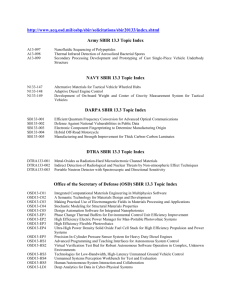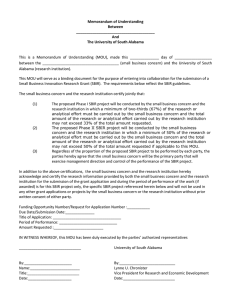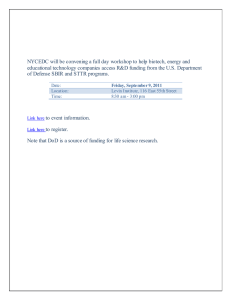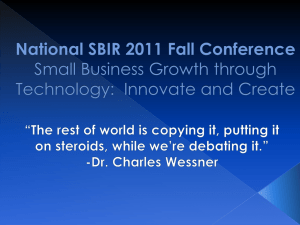CS 411W XI – SBIR and Grant Proposal Writing
advertisement
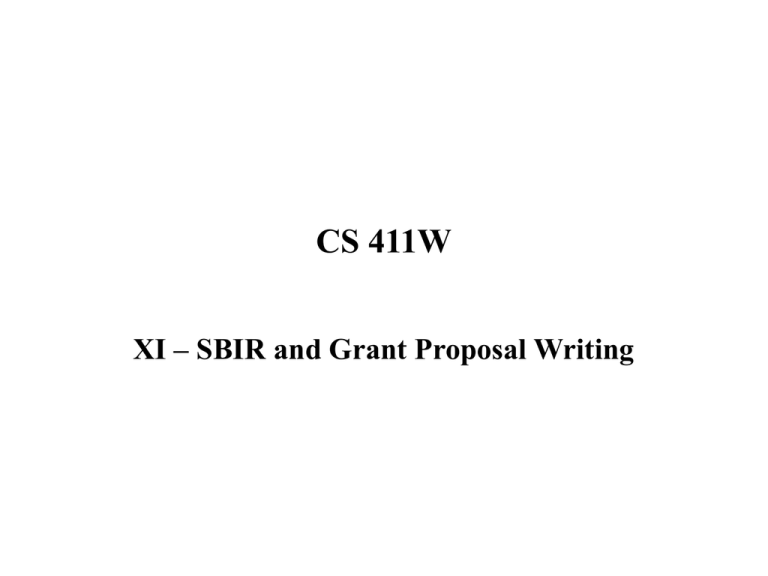
CS 411W XI – SBIR and Grant Proposal Writing SBIR/Grant Requests Objective: To obtain Research and Development funding to transition from a concept to product (the alternative is to finance it yourself…) SBIR Advantage: Small Business retains rights to technical data for a period of 4 years – gives small business opportunity to market the product – prevents other/larger organizations from taking unfair advantage SBIR/Grant Requests (cont) Federal Grants: A Federal Grant is an award of financial assistance from a Federal agency to a recipient to carry out a public purpose of support or stimulation authorized by a law of the United States. – Grants are not Federal assistance or loans to individuals. – A grant is not used to acquire property or services for the Federal government's direct benefit. SBIR/Grant Requests (cont) Federal Grants - Eligibility: Many groups of organizations are eligible to apply for government grants: – – – – – – Government Organizations Education Organizations Public Housing Organizations Non-Profit Organizations Small Businesses Individuals SBIR/Grant Requests – Writing Proposals What is a proposal? A business proposal is an offering from a seller to a prospective buyer – The written proposal is the vehicle that carries the terms of an agreement between buyer and seller and forms the basis for a subsequent business contract. – Proposals can range in size from a one page letter, or price list, to several hundred pages of detailed specifications. – If the proposed offer is accepted by the buyer, it creates a legally binding document for both parties, buyer and seller. Writing Proposals - Process Proposal Process: The proposal provides a formal way for both sides to communicate in writing during these negotiations. – Prospective buyers sometimes issue a Request for Proposals (RFP), or an Invitation for Bids (IFB), to provide specific information about what products or services they want – RFP/IFB will include specifications of the customer's requirements – The RFP/IFB will typically be issued to solicit responses from several offers to establish a competitive bidding environment – A proposal is written in response to the RFP/IFB Writing Proposals - Objectives Proposal Objectives: The major objectives in writing proposal are: – To describe how the customer requirements will be met – To establish the price and payment terms for the proposed effort, goods, or services – To define the terms and conditions that will apply to both parties during if the proposal is accepted Writing Proposals – Components Components of a Proposal: The basic components of the business proposal include: – Technical Proposal and – Cost or Price proposal. Writing Proposals – Components (cont) Technical Proposal: Conveys the sellers understanding of the – – customer’s requirements and technical details of the offer: Provides a detailed description of the technical approach to meeting the requirements Identifies the seller’s key discriminators to convince the customer to select the proposal. Discriminators may include: • Technical qualifications • Development or production process • Management approach • Risks and how they will be addressed • Program plan outline/schedule and milestones Writing Proposals – Components (cont) Cost Proposal: Provides a price breakdown for major aspects of the offer which may include: • • • • • • Non-recurring Costs - those costs associated with producing a “first article” Recurring Costs – the cost of producing/delivering additional product Labor costs – expressed in one or more combinations terms of cost/man hour, total man hours, total labor costs, etc. Material Costs – parts, assemblies, supplies required to produce the product Other Costs – travel, license fees, consultants, etc. Contractual Terms and Conditions of the offer Additional Proposal Objectives To educate the prospective customer about the full nature of his need – Often, a prospective customer may be aware of only a portion of his need – the proposal may describe a more complete and valid solution/approach – Provides a detailed cost assessment as basis for comparison of the overall approach to cost from multiple (competing) offers Proposal Preparation Checklist Key considerations for developing a successful proposal: 1. Does your proposal address the underlying purpose of the customer’s need? 2. Is there any danger that the customer could misunderstand your approach to provide him with a solution? Have you clearly presented your approach? 3. Is the work you intend to perform covered in sufficient detail? 4. Have you expressed compelling enough reasons why you should be selected to supply the goods or services? 5. Is your proposal written from your customer’s perspective? Do you use language with which he is familiar? Do you know his personal or his organization's key objectives? 6. Are your fees or costs clearly stated? Do they follow a description of your approach and benefits? 7. Will the customer understand what he or she is supposed to do upon reading the proposal? Methods for Proposal Preparation 1. Prepare an Introduction: • Start with a Theme: Concise statement which describes what you are offering and why it meets the customer needs – • Example: XYZ solution provides a secure method for ensuring rapid and accurate assessment of insurance claims Convey your understanding of the customer requirement and provides a top-level view of how your proposal addresses those requirements Methods for Proposal Preparation 2. Describe your Technical Approach: Provide a detailed description of your approach and what it will accomplish • Describe major technical objectives and activities • Identify risks, challenges, and approaches to dealing with them • Describe the outcome in terms of meeting customer’s requirements • Identify key personnel and their qualifications • Describe the facilities and equipment required to complete the effort. Methods for Proposal Preparation (cont) 3. Describe your “Commercialization Strategy” • Describe how your product satisfies a market requirement • Example: Small, light weight, feedback controllable actuators could find wide application by both military and commercial entities for telerobotics applications. Products could include: actuators, simulation software, compact brakes, active vibration control modules,etc. Methods for Proposal Preparation (cont) 4. Provide a Schedule, Identify Milestones, define Deliverables: • Prepare a schedule which reflects a top-level Work Breakdown Structure • Identify and discuss major milestones • List deliverables (routine reports, product documentation, equipment or product) Methods for Proposal Preparation (cont) 5. Prepare the Cost/Price Proposal: The Cost proposal is often delivered in a separate (sealed) package from the Technical Proposal. • Cost Proposal format is often dictated by the RFP • “Cost” will include the costs you will incur plus the earnings you expect (Cost + Earnings = Price) • Cost/price breakdown should provide customer with sufficient information to evaluate your offer for cost/price reasonableness Methods for Proposal Preparation (cont) • Simple Cost/price Breakdown: The table below shows how scope of effort and associated cost/price might be presented for a simple effort: Should map at a high level to WBS or Schedule Shows what the customer gets (quantity of labor, cost of hardware) 1. Evaluate hardware 0ptions 100 man-hours 2. Select and order hardware 1/3 cost upfront 1/3 hardware cost 200 man-hours 1/3 cost 100 man-hours 50 man-hours 3. Install hardware 4. Debug system 5. Train TOTAL $10,000 $60,000 $60,000 $20,000 $60,000 $10,000 $5,000 $225,000 Methods for Proposal Preparation (cont) 6. Summarize Your Offer: Capture key components and discriminators of your proposal in a summary paragraph • Provides a concise recap of what you are offering • Can be used to hi-light qualifications, past experience, and key discriminators • • Example: “XYZ, the largest Database designer in the United States provides secure database design services for over 500 major clients including the Department of Defense, Department of Homeland Security, First National Bank, and Ford Motor Company. " May provide a comparison/recap of your solution compared to existing solutions or alternative solutions from potential competitors Lab V Phase II SBIR/Grant Proposal Cover Sheet (Product Name, Project Team Name, Date, etc.) Table of Contents, List of Figures, etc 1 Introduction Description of what is being proposed and why 2 Technical Approach Description of prototype capabilities and results Description of proposed activities to transition prototype to product – Detail tasks to be performed – Describe results to be achieved Identify Key Personnel Identify Facilities and Equipment required to complete the tasks to be performed 3 Commercialization Strategy 3 Schedule, Milestones, and Deliverables 4 Proposal Costs 5 Summary Reference Links SBIR Websites: http://www.sba.gov/SBIR/ http://www.acq.osd.mil/osbp/sbir/ http://grants.nih.gov/grants/funding/sbir.htm http://sbir.gsfc.nasa.gov/SBIR/SBIR.html Phase II Example: http://www.acq.osd.mil/osbp/sbir/proposals/smpl_prop2.htm
